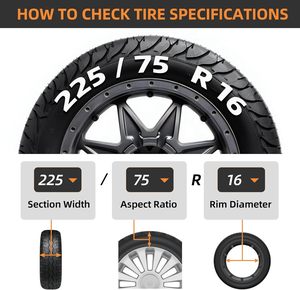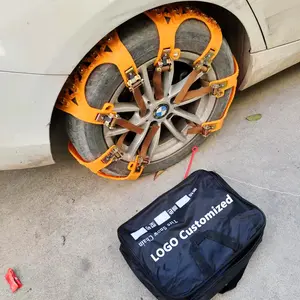(6091 products available)












































































































































































A car tire chain is a set of linked chains fitted to the external surface of a vehicle tire. Tire chains give increased traction and safety on snow and ice-covered roads. There are two types of tire chain cars:
Cable Chains
They are so named because they are made of steel cables. They are lighter and less noticeable. As a consequence, they provide less traction than other chain types. Cable chains are more tolerant of modern vehicles' limited fender clearance. They are available in a variety of sizes to fit a wide range of tire sizes. They are also more affordable than other types of tire chains.
Chain Link Tire Chains
They are the most common type of tire chain. They are made of metal links that are arranged in a lattice pattern. This design provides superior grip on slick surfaces. However, they are heavier and need adequate fender clearance to install and remove. They come in a range of sizes and configurations to accommodate various tire sizes and driving requirements.
Link Thickness
Link thickness refers to the diameter of the wire that makes up each link of the chain. It varies from 1/8 to 3/8 inches, depending on the type of chain. Thicker links are more durable but also heavier. Different types of tire chains have varying link thicknesses.
Number of Links
The number of links indicates how many individual pieces of chain are on each side of the tire. Most tire chains contain between 8 and 18 links per side. More links provide better traction but can be more challenging to install and remove.
Chain Length
Chain length is measured in inches and corresponds to the circumference of the tire. Shorter chains wrap tightly around the tires for extra grip on slippery surfaces, while longer ones allow for more flexibility. Typical lengths range from 42 to 60 inches, depending on the chain style.
Clearance
Some tire chains require additional space between the wheel wells and the tires. This section is known as ""clearance"" and is measured in inches. Most chains need at least 1/4 to 1/2 inch of extra room to ensure proper fitment without rubbing against the vehicle.
Maintaining tire chains is essential to ensure they last and provide the best possible traction when needed. Here are some tips: Clean the chains after each use, especially if they have been used on salted roads. Rinse off the salt or debris with water. Allow the chains to dry completely before storing them. This prevents rusting of the metal links. Inspect the chains regularly for any broken links or damage. Replace any worn parts promptly to maintain optimal performance. Lubricate the chains once per season with a light oil. This reduces friction between the links and helps them move smoothly. When not in use, store the chains in a cool, dry place away from sunlight. Excess heat or moisture can weaken the material over time. Proper care will extend the life of tire chains and ensure they provide reliable traction in winter conditions.
There are a variety of options for tire chains, and they all serve a different purpose. When buying tire chains for cars, it's essential to consider the following factors:
Size
To select the correct chain size, measure the tire's width, aspect ratio, and diameter. The size must correspond with the tires for proper fitment. An incorrect size will not provide the needed traction and may damage the car or the chains.
Type
Consider the type of chains that will best suit the application. For instance, if the chains are for commercial use, heavy-duty chains are ideal. Similarly, if the car is for luxury, the Tire cable chains will offer the needed comfort.
Material
The most common material for tire chain cars is steel. It's durable and corrosion-resistant. However, chains made of other materials like tungsten offer superior performance but are more expensive.
Installation
Some chains are easy to install, while others require special tools. For example, the tire chain installation requires a tensioning tool for proper fitting. Consider how much time and expertise are available to install the chains. If installing on the roadside, quick-fit chains are ideal.
Clearance
Some cars have limited clearance between the tires and the wheel wells. In such cases, low-profile tire chains are ideal. Additionally, consider the chain's tread patterns and ensure they fit within the car's wheel well.
Regulations
Some countries and states have specific regulations concerning tire chains. For instance, they may specify the minimum link thickness. Ensure the chains purchased comply with all relevant rules and regulations.
Installing and replacing car chains for tires can be a straightforward process with the right steps. The following steps demonstrate how to install and replace tire chains safely and effectively:
Q1: Can tire chains be used on all vehicles?
A1: No, tire chains cannot be used on all vehicles. There are restrictions on their use in some places, especially on high-speed roads. Additionally, some modern vehicles with limited tire clearance may not be able to accommodate chains.
Q2: How fast can a vehicle go with tire chains?
A2: When tire chains are installed, the vehicle's maximum speed is typically limited to 30 mph (48 km/h). This is because using chains at higher speeds can cause rapid wear or damage to the chains as well as the road.
Q3: Are tire chains for sale in different sizes?
A3: Yes, tire chains are available in various sizes to fit different tire dimensions. It is crucial to select a chain size that matches the specific tire size to ensure proper fit and performance.
Q4: How does one know if tire chains are needed?
A4: The requirement for tire chains depends on the driving conditions. If driving in snowy or icy conditions, especially in areas with steep inclines, tire chains provide better traction and safety. Some regions have chain requirements during severe winter weather.
Q5: Can tire chains be reused?
A5: Yes, tire chains can be reused as long as they are adequately maintained and remain in good condition. Before reinstalling, inspecting the chains for wear or damage and ensuring they fit correctly on the tires is essential.